Thomas Rogers Kimball
Thomas Rogers Kimball (April 19, 1862 – September 7, 1934) was an American architect in Omaha, Nebraska. An architect-in-chief of the Trans-Mississippi Exposition in Omaha in 1898, he served as national President of the American Institute of Architects from 1918–1920 and from 1919-1932 served on the Nebraska State Capitol Commission.[1]
Thomas Rogers Kimball | |
|---|---|
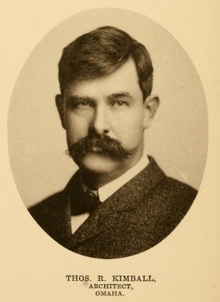 Thomas Rogers Kimball | |
| Born | April 19, 1862 Linwood, Ohio (now a neighborhood within Cincinnati) |
| Died | September 7, 1934 (aged 72) |
| Citizenship | United States |
| Alma mater | University of Nebraska (now U of N–Lincoln) Massachusetts Institute of Technology École des Beaux-Arts |
| Occupation | Architect |
| Spouse(s) | Annie McPhail Kimball |
Kimball was credited with pursuing 871 commissions, which included designing 167 new residential buildings and 162 new non-residential structures, served as architectural adviser to commissions responsible for erection of Missouri and Nebraska state capitols, the Kansas City Liberty Memorial, and the Indiana state war memorial in Indianapolis, and was member of national council of fine arts established by U.S. President Theodore Roosevelt to evaluate all plans for public buildings, monuments, and statutes.[2][3][4]
Biography

Born April 19, 1862 in Linwood, Cincinnati, Ohio, he moved to Omaha, Nebraska with his parents when he was in his early teens. After graduating from high school in 1878, he attended the University of Nebraska (currently the University of Nebraska-Lincoln) for two years, but did not graduate. He next went to Boston, where he worked with a private tutor for another two years. Kimball then entered the Massachusetts Institute of Technology, where he studied architecture until 1887. He did not graduate, but was later given an affiliation with the School of Architecture.
Kimball then moved to Paris, where he spent a year studying art at L'Ecole des Beaux Arts. Returning to Boston in 1888, he began working for a publishing company. The following year, Kimball married Annie McPhail in Boston.[5]
Walker and Kimball
In 1891, Kimball formed an architectural firm with MIT instructor C. Howard Walker and architect Herbert Best. Best soon retired. Walker remained in Boston to run the office there; Kimball moved back to Omaha and opened an office. Both operated under the name Walker and Kimball. In 1892, Kimball was commissioned to design a public library building in Omaha. Although Kimball had been able to get the job through connections established by his father, railroad executive Thomas Lord Kimball, the younger Kimball was in fact well qualified for the work. He was also something of a curiosity in 1890s Omaha, since he had been educated in the East and had studied architecture both in the United States and in France. Kimball began attracting many high-profile projects in Omaha, including St. Frances Cabrini Church and the Burlington Train Station. In 1893, some of his architectural plans were shown in Chicago at the World Columbian Exposition.[6]
Trans-Mississippi Exposition
The 1898 Trans Mississippi and International Exposition was a World's Fair-like event that required the construction of many buildings. Kimball and Walker were named co-architects-in-chief for the event. The two men were responsible for the overall site development, including perimeter buildings. They designed several major buildings, some smaller structures and the Arch of States (a main entrance). "The other 'name' architects who were there did a main building and nothing else," Batie said.
The buildings were constructed of strips of wood covered with staff, which was a mixture of plaster and horsehair. They were temporary by design, built at about half the cost of permanent buildings. The lower cost allowed the construction of larger structures. Kimball was already successful, but his Exhibition work made him even more so. Kimball won commissions for major new projects, such as St. Cecilia Cathedral and the Fontenelle Hotel in Omaha, and the Electricity Building at the 1904 World's Fair in St. Louis.[7]
Late career
By 1918, he had gained tremendous stature among his peers and was elected national president of the American Institute of Architects, an office he held until 1920. Kimball was involved in many architecture-related activities, including supervision of the 1920 design contest that selected Bertram Goodhue as architect of the Nebraska State Capitol.
In 1927, Kimball went into a partnership with architects William L. Steele (1875–1949) and Josiah D. Sandham (1880–1969) to form the firm Kimball, Steele, and Sandham. Among other commissions, the firm designed the Second Church of Christ Scientist (Minneapolis, 1930) and with George B. Prinz were associate architects on the Federal Office Building (Omaha, 1933). However, Kimball functioned primarily as a consultant, having stopped working as an active architect.[8][9]
Death and legacy
Kimball's success could not survive the Great Depression, which hurt him financially. He died a pauper in 1934. Upon his death, partner William L. Steele remarked that Kimball "did not...as the majority of his contemporaries did, absorb a repertoire of French tricks and come home. He studied architecture as building, not as merely drawings of the buildings. He seemed to have acquired at an early age that grasp of fundamental principles which was to keep him from being stampeded by passing fads."[10]
In 2017, Kimball was selected as the 26th member of the Nebraska Hall of Fame. In 2019, he was formally inducted with the creation of a bust of his likeness to be displayed in the Nebraska State Capitol.[11]
Notable designs
.jpg)
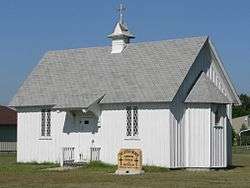
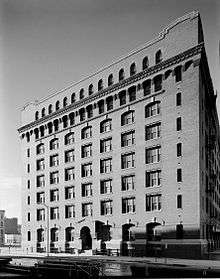

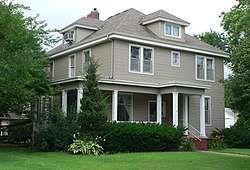
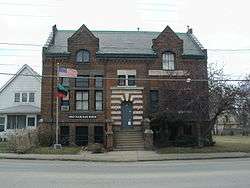
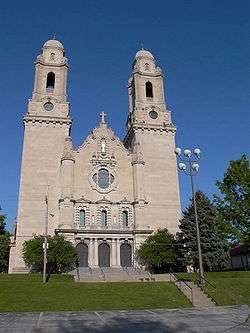
| Notable designs by Thomas Rogers Kimball alphabetical order | |||||
|---|---|---|---|---|---|
| Name | Built | Location | Notes | ||
| All Saint's Episcopal Church | 1906 | 26th and Dewey Avenue | Kimball took the contract for designing this building away from John McDonald, another influential architect in Omaha, after a fire destroyed the original church. He designed a parish house and church, both of which were demolished in 1966 when the church moved to another location.[12] | ||
| Battle Mountain Sanitarium | 1898 | Hot Springs, South Dakota | Designed in a star pattern for sun and air, today the building is known as the Domiciliary at the Hot Springs Medical Center of the VA Black Hills Health Care System.[13] | ||
| Breckenridge/Gordon Residence | 1909 | 3611 Jackson Street, Omaha | A family residence listed on the NRHP.[14] | ||
| Burlington Headquarters Building | 1879 | 1002-1006 Farnam Street, Omaha | This Downtown Omaha landmark sits on the Gene Leahy Mall, and was rehabilitated by Kimball in 1879. It was added to the National Register of Historic Places, or NRHP.[15] | ||
| Burlington Station | 1900 | First Street and St. Joseph's Avenue, Hastings, Nebraska | Added to the NRHP in 1978. It was renovated in 1966 and 2000. | ||
| Burlington Train Station | 1898 | 925 South 10th Street, Omaha | Added to the NRHP in 1974; currently used as the studio facility for Omaha's ABC affiliate, television station KETV (channel 7). | ||
| Dome Lake Club | 1895 | 56 Dee Drive, Sheridan, Wyoming | This private fishing club is located near the Bighorn National Forest.[16] | ||
| F.P. Kirkendall House | 1901 | 3727 Jackson Street, Omaha | Ranking among the largest of the Gold Coast Historic District homes, this house has won several awards.[17] | ||
| Gallagher Residence | 1904 | 513 South 38th Street, Omaha | A prominent home throughout its life, it was designed for Ben Gallagher, the founder of the Paxton and Gallagher Wholesale Grocery Company in pioneer Omaha. It was demolished in 1967.[18] | ||
| Hall County Courthouse | 1904 | 422 West 1st Street, Grand Island, Nebraska | This building serves Hall County government offices, and was added to the NRHP in 1977.[19] | ||
| Hotel Fontenelle | 1914 | 1806 Douglas Street, Omaha | This building was demolished in 1983. | ||
| Keystone Community Church | 1908 | Keystone, Nebraska | The church has a Catholic altar on one end, a Protestant lectern at the other, and hinged pews to make the seats reversible.[20] | ||
| Mary Rogers Kimball House | 1905 | 2236 St. Mary's Avenue, Omaha | Built close to her son's home, this house is the only remaining example of the numerous upscale homes that used to sit on St. Mary's. It is listed on the NRHP.[21] | ||
| Medical Arts Building | 1926 | 17th and Dodge Streets, Omaha | Originally designed as an all-in-one medical office and laboratory facility, Kimball withdrew when the builders went bankrupt. He eventually sold the plans to John McDonald, a local competitor. The building was demolished in 1999.[22] | ||
| Monmouth Park School | 1903 | 4508 North 33rd Street, Omaha | Added to the NRHP in 1983, this building was converted to apartments in 1985. | ||
| Nash Block | 1905 | 902 Farnam Street, Omaha | Added to the NRHP in 1985, this building is currently apartments.[23] | ||
| Nebraska Telephone Company Building | 1894 | 128-130 S. 13th Street, Lincoln, Nebraska | Listed on the NRHP.[16][24] | ||
| Old Administration Building | 1903 | University of Nebraska at Lincoln campus | This building was razed in 1963.[1][25] | ||
| Omaha Country Club | 1900 | [16] | |||
| Omaha Public Library | 1892 | 1823 Harney Street, Omaha | Called "one of the most significant structures in Nebraska", this building sits on land originally donated to the city by local real estate mogul Byron Reed. It was Kimball's first commission in Omaha, and served as the public library in Omaha until 1977, when afterwards it was converted to offices, in which capacity it still serves. It is listed on the NRHP.[26] | ||
| Oscar Roeser House | 1908 | 721 W. Koenig Street, Grand Island, Nebraska | |||
| Packers National Bank | 1907 | 4939 South 24th Street, Omaha | Located in the South Omaha Main Street Historic District, this building serves as offices today, and is listed on the NRHP individually.[27] | ||
| Park School | 1918 | 1320 South 29th Street, Omaha | Named for its proximity to Hanscom Park, this building was sold by Omaha Public Schools in 1988 and converted to apartments.[28] | ||
| Paxton and Gallagher Warehouse | 1908 | 901-909 Jones Street, Omaha | Currently serves as apartments.[29] | ||
| Richard R. Kimball Residence | 1901 | 1235 Park Wild Avenue, Omaha | Built for Kimball's brother, a prominent automobile dealer, this house was demolished in the mid 1960s.[30] | ||
| St. Cecilia Cathedral | 1905 | 701 North 40th Street, Omaha | Completed in 1959, Kimball's original designs were altered by later architects. | ||
| St. Francis Cabrini Church | 1908 | 1335 South 10th Street, Omaha | Built as St. Philomena's Cathedral, this structure retained cathedral status until St. Cecilia's Cathedral was substantially completed around 1916.[31] | ||
| St. Philomena's Catholic Church | 1908 | 1335 South 10th Street | Considered one of Kimball's best works, this building is listed on the NRHP, and is currently named St. Francis Cabrini.[32] | ||
| Second Church of Christ Scientist (now Ivy Hotel) | 1930 | 1115 2nd Avenue South, Minneapolis, Minnesota | A locally designated landmark, this building is a rare example of the Ziggurat form in the city.[33] | ||
| South Omaha Public Library | 1904 | 2302 M Street, Omaha | This Carnegie library was designed to be reminiscent of a small Italian Renaissance palazzo. It was demolished in 1953 and replaced with a modern library at the same location.[34] | ||
| Thomas R. Kimball Residence | 1905 | 2450 St. Mary's Avenue, Omaha | Curved drives, elevated gardens and illustrious landscaping surrounded this multi-towered, seven-chimneyed building with design elements from many styles. It was demolished six years after Kimball's death and replaced with a grocery store and parking lot.[35] | ||
| Wattles House | 1895 | 320 South 37th Street, Omaha | Banker Gurdon Wattles lived here for 25 years, during which time he planned the Trans-Mississippi and International Exposition, among his many ventures.[36] | ||
| Webster Telephone Exchange Building | 1907 | 2213 Lake Street, Omaha | Serving as a telephone exchange, emergency morgue, community center, and museum has not saved this building from disrepair.[37] | ||
| William F. Baxter Residence | 1926 | 410 South Elwood Boulevard | One of the last large residential plans by Kimball before he died, this home is on the University of Nebraska at Omaha campus and is threatened by a student housing project.[38][39] | ||
Kimball also designed the original Omaha World-Herald building, the First National Bank in Grand Island and the Hastings, Nebraska Railroad Station. At the Trans-Mississippi and International Exposition he prepared the layout for the park and designed the Arch of the States, the Administration Building, Transportation Building, and the Boys' and Girls' Building.[6]
See also
- John Latenser, Sr.
- Joseph P. Guth
- Architecture in Omaha, Nebraska
- Omaha Landmarks
References
- Historic Buildings at UNL: Thomas R. Kimball. University of Nebraska. Retrieved 4/7/08.
- (1936) National Cyclopedia of American Biography. Volume 25, pp 364–365.
- (1942) Who Was Who in America. p 676.
- Withey, H. and Withey, E. (1956) Biographical Dictionary of American Architects. New Age Publishing. pp 344–345.
- Thomas Rogers Kimball Archived 2012-09-07 at Archive.today, Omaha Public Library. Retrieved 4/7/08.
- "Thomas Rogers Kimball", Nebraska State Historical Society. Retrieved 4/7/08.
- Thomas Rogers Kimball. Nebraska Social Studies Association. Retrieved 4/8/08.
- Thomas Kimball, City of Omaha Landmark Heritage Preservation Commission. Retrieved 4/6/08.
- Batie, David Lynn (Fall 1979). Kivett, Marvin F (ed.). "Thomas Rogers Kimball (1890-1912): Nebraska Architect". Nebraska History. Lincoln, Nebraska: Nebraska State Historical Association. 60 (3): 352.
- Batie, David Lynn (Fall 1979). Kivett, Marvin F (ed.). "Thomas Rogers Kimball (1890-1912): Nebraska Architect". Nebraska History. Lincoln, Nebraska: Nebraska State Historical Association. 60 (3): 327.
- https://journalstar.com/news/state-and-regional/govt-and-politics/architect-thomas-rogers-kimball-joins-nebraska-hall-of-fame/article_6b7f1739-37f4-5e5a-9312-9357b3bf19c4.html
- Gerber, K. and Spencer, J.C. (2003) Building for the Ages: Omaha's Architectural Landmarks. Omaha, NE: Landmarks, Inc. p 33.
- (1999) Wellness Magazine. Veterans Administration. Retrieved 4/7/08.
- Gerber, K. and Spencer, J.C. (2003) Building for the Ages: Omaha's Architectural Landmarks. Omaha, NE: Landmarks, Inc. p 118.
- Gerber, K. and Spencer, J.C. (2003) Building for the Ages: Omaha's Architectural Landmarks. Omaha, NE: Landmarks, Inc. p 52.
- Wishart, D.J. Encyclopedia of the Great Plains. Lincoln, NE: University of Nebraska Press. p 81.
- Gerber, K. and Spencer, J.C. (2003) Building for the Ages: Omaha's Architectural Landmarks. Omaha, NE: Landmarks, Inc. p 87.
- Gerber, K. and Spencer, J.C. (2003) Building for the Ages: Omaha's Architectural Landmarks. Omaha, NE: Landmarks, Inc. p 34.
- National Register Places in Hall County. Nebraska State Historical Society. Retrieved 4/6/08.
- "Thomas R. Kimball Elected to Nebraska Hall of Fame". Nebraska History News. Lincoln, Nebraska, USA: The Nebraska State Historical Society. 71 (4): 8–9. 2017.
- Gerber, K. and Spencer, J.C. (2003) Building for the Ages: Omaha's Architectural Landmarks. Omaha, NE: Landmarks, Inc. p 104.
- Gerber, K. and Spencer, J.C. (2003) Building for the Ages: Omaha's Architectural Landmarks. Omaha, NE: Landmarks, Inc. p 43.
- Nash Block. City of Omaha Landmark Heritage Preservation Commission. Retrieved 10/06/07.
- "More Registered Placed in Lancaster County." Nebraska State Historical Society. Retrieved 4/7/08.
- "Old Administration Building", University of Nebraska. Retrieved 4/7/08.
- Gerber, K. and Spencer, J.C. (2003) Building for the Ages: Omaha's Architectural Landmarks. Omaha, NE: Landmarks, Inc. p 73.
- Gerber, K. and Spencer, J.C. (2003) Building for the Ages: Omaha's Architectural Landmarks. Omaha, NE: Landmarks, Inc. p 109.
- Gerber, K. and Spencer, J.C. (2003) Building for the Ages: Omaha's Architectural Landmarks. Omaha, NE: Landmarks, Inc. p 151.
- Gerber, K. and Spencer, J.C. (2003) Building for the Ages: Omaha's Architectural Landmarks. Omaha, NE: Landmarks, Inc. p 116.
- Gerber, K. and Spencer, J.C. (2003) Building for the Ages: Omaha's Architectural Landmarks. Omaha, NE: Landmarks, Inc. p 30.
- "St. Francis Cabrini Catholic Church", City of Omaha Landmark Heritage Preservation Commission. Retrieved 4/6/08.
- Gerber, K. and Spencer, J.C. (2003) Building for the Ages: Omaha's Architectural Landmarks. Omaha, NE: Landmarks, Inc. p 113.
- "Second Church of Christ Scientist", City of Minneapolis. Retrieved 4/7/08.
- Gerber, K. and Spencer, J.C. (2003) Building for the Ages: Omaha's Architectural Landmarks. Omaha, NE: Landmarks, Inc. p 31.
- Gerber, K. and Spencer, J.C. (2003) Building for the Ages: Omaha's Architectural Landmarks. Omaha, NE: Landmarks, Inc. p 32.
- Gerber, K. and Spencer, J.C. (2003) Building for the Ages: Omaha's Architectural Landmarks. Omaha, NE: Landmarks, Inc. p 77.
- Gerber, K. and Spencer, J.C. (2003) Building for the Ages: Omaha's Architectural Landmarks. Omaha, NE: Landmarks, Inc. p 112.
- Gerber, K. and Spencer, J.C. (2003) Building for the Ages: Omaha's Architectural Landmarks. Omaha, NE: Landmarks, Inc. p 170.
- (2007) "Landmarks News", Landmarks, Inc. Retrieved 4/6/08.